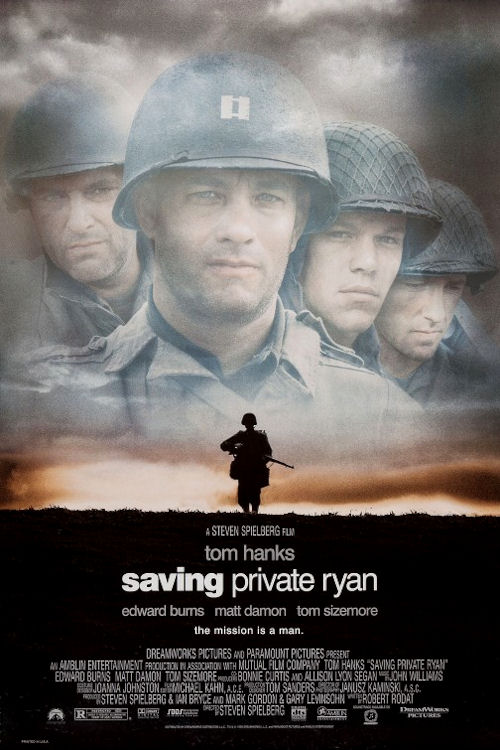Anthony's Film Review
Saving Private Ryan (1998)

Saving Private Ryan is easily among the best in the war movie genre...
In the United States military, there is one code that is always honored and never broken: leave no man behind. While it is true that the success of the overall mission to win the war is paramount, we cannot forget that one individual is just as important as the overall armed forces. Therefore, when one soldier is wounded, he is taken care of and brought to safety as quickly as possible. And if the soldier dies, his death is reported back so that he is never forgotten to loved ones back home. This devotion among soldiers to one another creates a brotherhood in the face of battle, and reminds us that America would not be free without the sacrifices of these soldiers.
Speaking of sacrifice, the first scene of Saving Private Ryan, directed by Steven Spielberg, is definitely a reminder of that. It shows an old man slowly walking to a cemetery and stopping at one particular grave site. He stares at it for a bit before he begins to cry. Throughout this scene, there is really no dialogue. Just images that are carefully shot so that we can take in the vast number of people who died in war and how each death is one soldier's loss of life but enduring life for many others. It's the perfect transition into the next scene: the D-Day landing on the beaches of France.
Spielberg's portrayal of this horrific and deadly battlefield is no doubt an unforgettable one. When U.S. soldiers in landing craft approach the beach, there is a sense of dread about what is to come. Then, when it's actually time to exit, several men already get shot by Nazi bullets. From there, it's a hellish trek across a field of death and destruction. The entire scene, which lasts a little over 20 minutes, is done carefully so that we can take in the details, just like the first scene at the cemetery. The main characters, including Tom Hanks as Captain Miller and Tom Sizemore as Sergeant Horvath, work together to survive their ordeal and advance inland as part of their mission against the Nazis.
You would think that this is a World War II movie depicting the familiar major events of that war. But it isn't. The preceding 20-minute sequence is actually there to set the stage for the real heart of the movie. What follows is a scene where women at typewriters are preparing official telegrams that will be sent to the next of kin of American soldiers killed in action. One of the women notices that three telegrams are for three brothers from the same company who have been killed, yet a fourth brother, Private James Ryan, is not among the dead. After a bit of discussion, a decision by the U.S. Army Chief of Staff is made to send a rescue team to save Private Ryan and bring him home.
Captain Miller is the one who is asked to carry out this operation. He leads an eight-man company across the French countryside in hopes of finding information that could lead to Private Ryan's whereabouts, as the only detail available from the start is the soldier's last-known drop location. On the way, they come across other U.S. army camps as well as some Nazi soldiers. Even if they're far from the deadly beaches, they may still be forced to face the possibility of death while opening fire on any threat that comes their way. And once they are much closer to completing their objective, they may find that their plans must change.
I'll leave my plot description right there, for the sake of not giving away the rest of the movie. Just know that the last part of the movie is as great as everything before it. Steven Spielberg knows how to make us feel intense emotion, whether it's related to the brutality of war or the value of sacrifice. If you love his previous work, particularly Schindler's List (another movie set in World War II), you'll certainly love Saving Private Ryan. It's a film that can help us truly understand the horrors, trials, and heroism that soldiers face in war.
Anthony's Rating:










For more information about Saving Private Ryan, visit the Internet Movie Database.
Home
Film Reviews
Other Reviews
Commentaries
Links
About AFR
RSS Feed
Privacy Policy
E-mail Anthony











